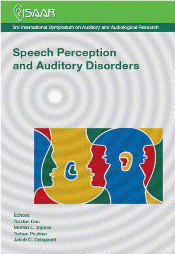Acoustic simulation of cochlear implant hearing
Abstract
One aim in current cochlear implant (CI) research is to improve and opti- mize speech processing strategies. During the development of new strate- gies acoustic simulations of CI hearing have widely been used for evalua- tion. These models usually take audio signals as input and mimic the effects of CI signal processing. In the present paper a new algorithm of acoustic simulation is presented, which transforms stimulation patterns of any co- chlear implant directly into an audio signal. Therefore it is independent of the CI strategy used for generating the stimulation pattern. Technical aspects like current spread and physiological aspects including loudness perception and phase locking capabilities of the simulated CI listener can be config- ured. The presented algorithm was used to evaluate and compare two differ- ent CI speech processing strategies in terms of speech intelligibility and pitch discrimination. The results show that acoustic simulation can help es- timate the amount of useful information in a CI stimulation pattern and hence be a help in evaluating CI strategies.
References
Black, R. C., Clark, G. M., Tong, Y. C., and Patrick, J. F. (1983). “Current distribu- tions in cochlear stimulation” Ann. N.Y. Acad. Sci., 405, 137-145.
Dorman, M.F., Loizou, P.C., and Rainey, D. (1997) “Speech intelligibility as a func- tion of the number of channels of stimulation for signal processors using sine- wave and noise-band outputs“ J. Acoust. Soc. Am., 102, 2403-2411.
Fu, Q. J. and Shannon, R. V. (1998). “Simulating effects of amplitude nonlinearity on phoneme recognition by cochlear implant users and normal-hearing listen- ers“ J. Acoust. Soc. Am., 104, 2570-2577.
Greenwood, D. D. (1990). “A cochlear frequency-position function for several spe- cies - 29 years later“ J. Acoust. Soc. Am., 87, 2592-2605.
Kral, A., Hartmann, R., Mortazavi, D., and Klinke, R. (1998). “Spatial resolution of cochlear implants : The electrical field and excitation of auditory afferents” Hearing Research, 121, 11-28.
Shannon, R.V., Zeng, F.G., Kamath, V., Wygonski, J., and Ekelid, M. (1995). “Speech recognition with primarily temporal cues” Science, 270, 303-304.
de la Torre Vega, Á., Martí, M. B., de la Torre Vega, R., and Quevedo, M. S. (2004). “Cochlear implant simulation version 2.0 : Description and usage of the program“ University of Granada, Spain.
Additional Files
Published
How to Cite
Issue
Section
License
Authors who publish with this journal agree to the following terms:
a. Authors retain copyright* and grant the journal right of first publication with the work simultaneously licensed under a Creative Commons Attribution License that allows others to share the work with an acknowledgement of the work's authorship and initial publication in this journal.
b. Authors are able to enter into separate, additional contractual arrangements for the non-exclusive distribution of the journal's published version of the work (e.g., post it to an institutional repository or publish it in a book), with an acknowledgement of its initial publication in this journal.
c. Authors are permitted and encouraged to post their work online (e.g., in institutional repositories or on their website) prior to and during the submission process, as it can lead to productive exchanges, as well as earlier and greater citation of published work (See The Effect of Open Access).
*From the 2017 issue onward. The Danavox Jubilee Foundation owns the copyright of all articles published in the 1969-2015 issues. However, authors are still allowed to share the work with an acknowledgement of the work's authorship and initial publication in this journal.


